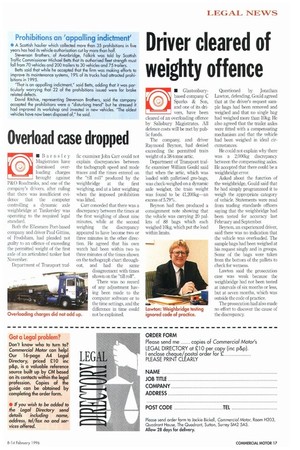Driver cleared of weighty offence
Page 19

If you've noticed an error in this article please click here to report it so we can fix it.
• Glastonburybased company C Sparks & Son, and one of its drivers, have been cleared of an overloading offence by Salisbury Magistrates. All defence costs will be met by public funds.
The company and driver Raymond Beynon, had denied exceeding the permitted train weight of a 38-tonne artic.
Department of Transport traffic examiner William Gould said that when the &tic, which was loaded with palletised gm-bags, was check-weighed on a dynamic axle weigher, the train weight was found to be 41,200kg—an excess of 5.79%.
Beynon had then produced a consignment note showing that the vehicle was carrying 20 pallets of 88 bags which each weighed 10kg, which put the load within limits. Questioned by Jonathan Lawton, defending, Gould agreed that at the driver's request sample bags had been removed and weighed and that no single bag had weighed more than 10kg. He also agreed that the trailer axles were fitted with a compensating mechanism and that the vehicle had been weighed in ideal circumstances.
He could not explain why there was a 2,000kg discrepancy between the compensating axles. He accepted that there could be a weighbridge error.
Asked about the function of the weighbridge, Gould said that he had simply programmed it to weigh the appropriate category of vehicle. Statements were read from trading standards officers saying that the weighbridge had been tested for accuracy last February and September.
Beynon, an experienced driver, said there was no indication that the vehicle was overloaded. The sample bags had been weighed at his request singly and in groups. Some of the bags were taken from the bottom of the pallets to check for wetness.
Lawton said the prosecution case was weak because the weighbridge had not been tested at intervals of six months or less, but at seven months, which was outside the code of practice.
The prosecution had also made no effort to discover the cause of the discrepancy




































































































